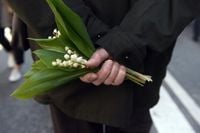As the calendar turns to May 1st, the streets of France come alive with the sweet scent of muguet, a tradition that stretches back centuries. This year, on May 1, 2025, vendors across towns and cities will be selling sprigs of this delicate flower, which has become a symbol of both spring and the labor movement.
The custom of offering muguet, or lily of the valley, dates back to the 16th century when it was originally a token of love rather than a labor commemoration. During this time, men—whether princes or commoners—would gift flower crowns to their beloveds, celebrating the arrival of spring. In 1561, King Charles IX formalized this charming tradition by presenting muguet to the ladies of the court, which quickly captured the hearts of many. Over the years, this practice evolved, and muguet became a gesture of affection shared not only among couples but also among family and friends.
While the muguet is now closely associated with Labor Day, its connection to this holiday is more recent. The origins of Labor Day itself trace back to 1889, when the Second Socialist International Congress designated May 1st as a day to advocate for an eight-hour workday. Initially, the red eglantine served as the emblem of the workers' movement, symbolizing their struggles and aspirations. However, in 1941, under the Vichy regime, Marshal Pétain officially established Labor Day as a public holiday and replaced the red eglantine with muguet, marking a significant shift in the symbolism of this day.
Despite its political history, the muguet has retained its charm and continues to be a beloved symbol of spring. As people gather to celebrate, many will wear a sprig of muguet pinned to their clothing, honoring both the beauty of the flower and the legacy of the labor movement. This dual significance is a reminder of the intertwined nature of love, renewal, and the fight for workers' rights.
Historically, the muguet has a rich tapestry of stories woven into its petals. The Romans celebrated its blooming as a herald of spring, while the Celts viewed this time as a symbol of nature's renewal. In Greek mythology, the flower is said to have been created by Apollo for his nymphs, serving as a soft and fragrant carpet for them to walk upon. Christian tradition attributes its origin to the blood of Saint Leonard, who was victorious over a dragon, further adding layers to the muguet's significance.
The Renaissance period saw a revival of the muguet as a romantic symbol, particularly among the nobility, who would craft flower crowns for their loved ones. The tradition of gifting muguet continued to flourish, especially after the events of May 1, 1886, in Chicago, where workers rallied for better labor conditions. This pivotal moment in labor history led to the establishment of May 1st as a day of protest and remembrance.
One of the most notable demonstrations occurred on May 1, 1891, in Fourmies, where a peaceful protest was violently suppressed, resulting in nine deaths and numerous injuries. This tragic event further solidified the muguet's association with the sacrifices made by workers in their fight for rights and recognition.
As the tradition evolved, the muguet became a symbol of hope and renewal, with its delicate white bells representing the arrival of spring and the promise of better days ahead. In 1895, the singer Félix Mayol popularized the flower by wearing it as a good luck charm before a performance in Paris, which helped to revive interest in the tradition. Parisian couturiers also began gifting muguet to their employees and customers, further embedding the flower into the cultural fabric of France.
Today, while the muguet is celebrated as a symbol of love, it is also a poignant reminder of the struggles faced by workers throughout history. The flower's journey from a romantic gesture to a symbol of labor rights reflects the broader societal changes that have occurred over the centuries. Even as the significance of May 1st has evolved, many still carry a sprig of muguet as a tribute to those who fought for workers' rights and as a celebration of spring's arrival.
In contemporary France, the muguet serves as a bridge between past and present, symbolizing not only the beauty of spring but also the enduring spirit of the labor movement. As people gather to offer or receive muguet, they participate in a tradition that honors both love and the legacy of those who have fought for fair labor practices. This May 1st, as vendors line the streets with their bouquets of muguet, the scent of the flowers will mingle with the echoes of history, reminding everyone of the power of tradition and the importance of solidarity.




